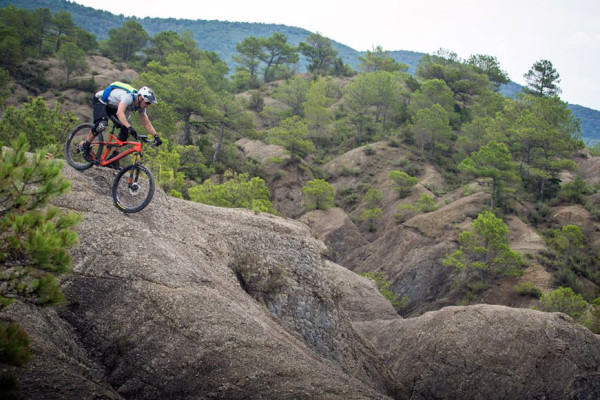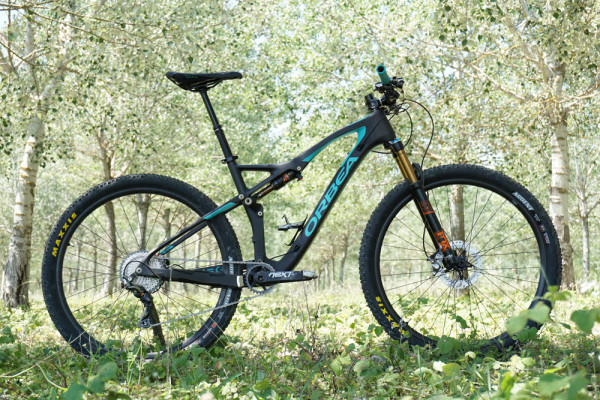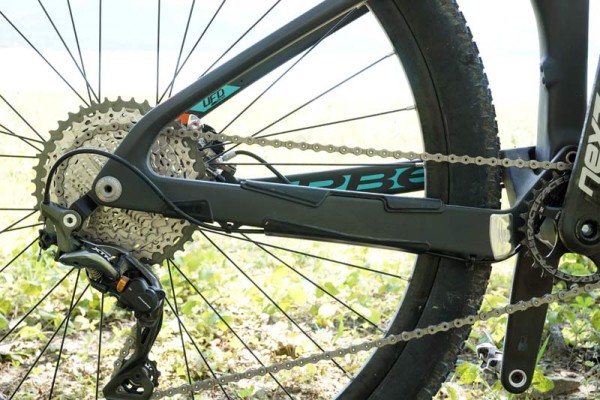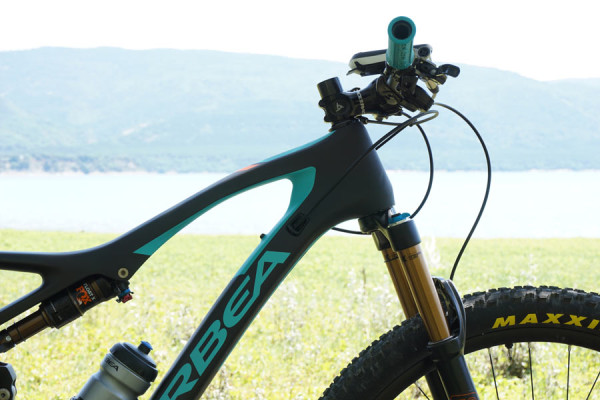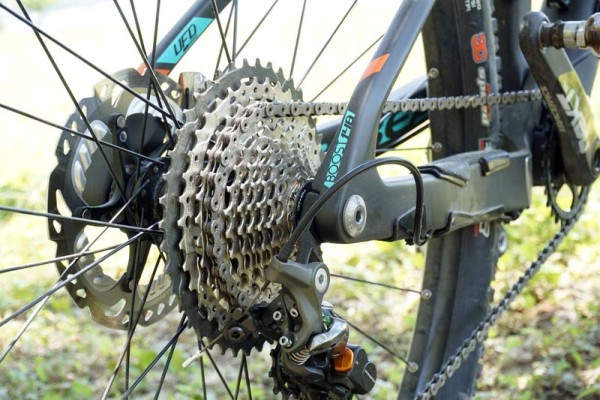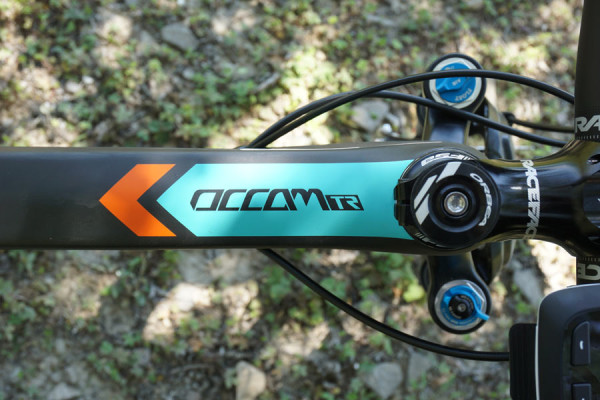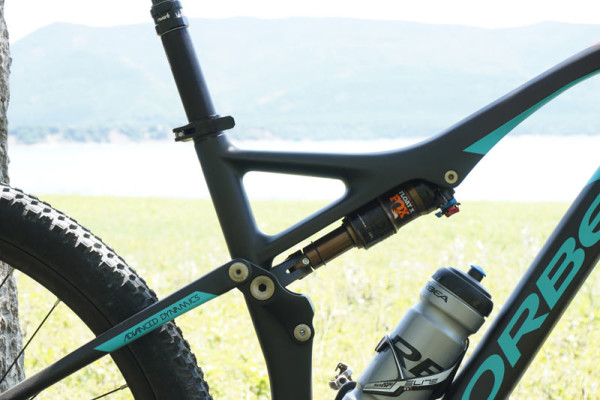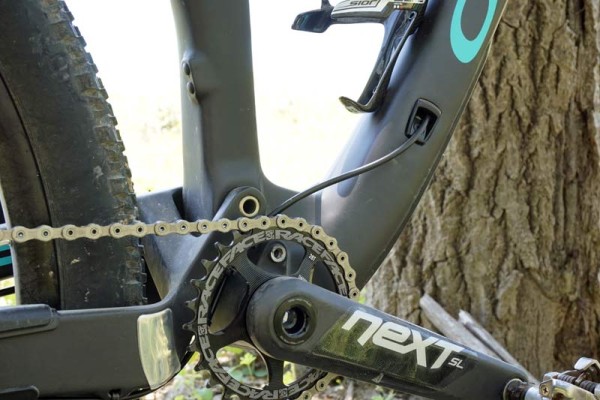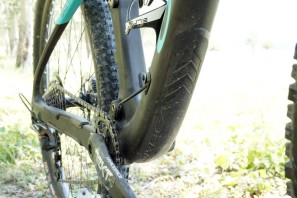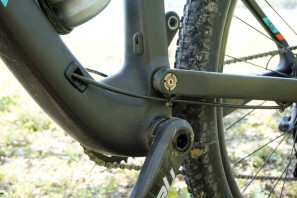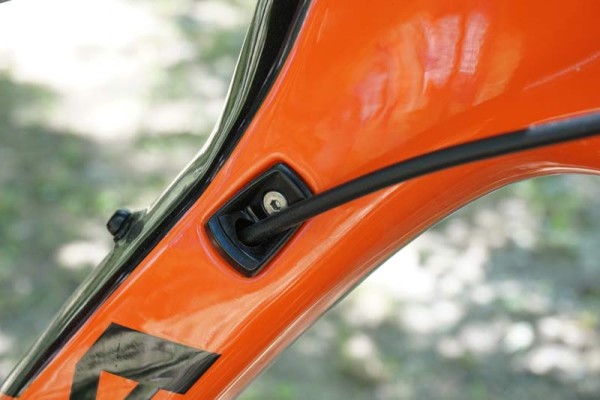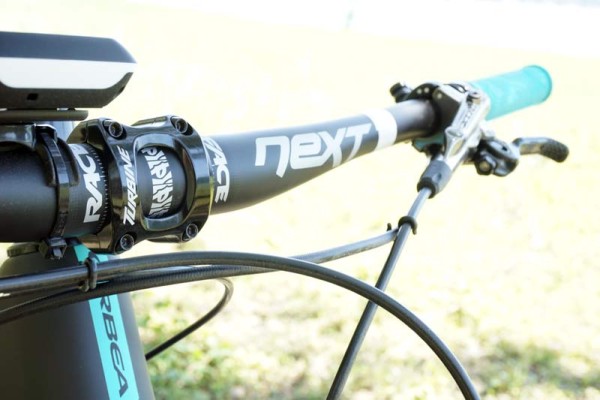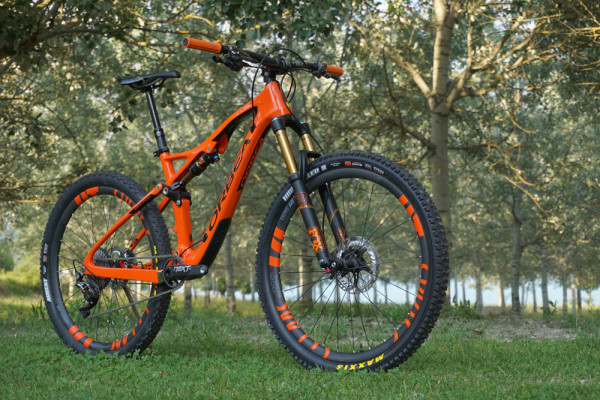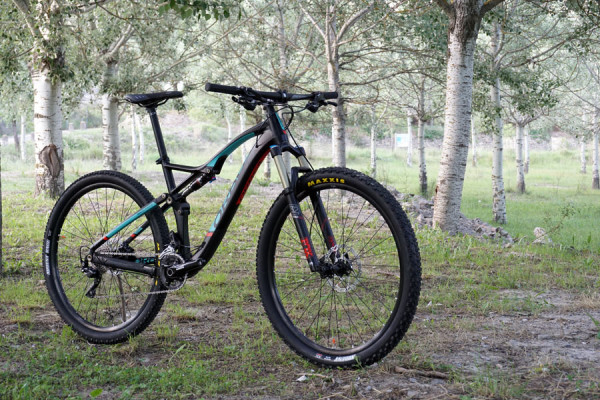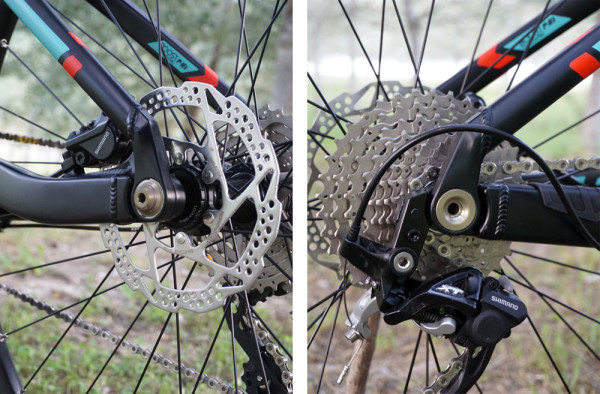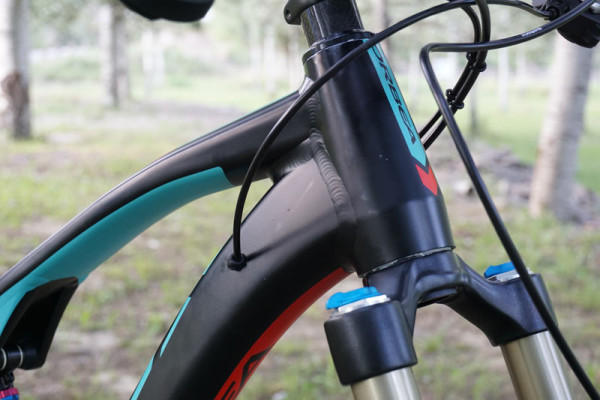The Orbea Occam was introduced in 2008, then updated in 2011 with their Advanced Dynamic suspension design. Then, a 29er Occam joined the mix in 2012. Now it’s getting its third edition, and it’s a massive step up in every regard, immensely capable and packed with user friendly features not found on any other mainstream bike.
Riders had told them they wanted something simple, and with clean lines. They wanted something that fit into the broadly interpreted Trail category, capable of riding most any terrain. So, Orbea traveled down the two-different-wheel-sizes road that’s become familiar for the brand. The prior Occam had 26″ and 29er, and the new Oiz introduced last year has 27.5″ and 29er. So, the Occam will also be available in 27.5” and 29er, but this time the bikes are differentiated by more than just wheel diameter – suspension travel and geometry are tweaked, too.
The Occam AM gets the smaller 27.5 wheels and 140mm travel front and rear with a slacker head angle. The Occam TR 29er gets 120mm travel and a half degree slacker seat tube. That’s up from the 120mm (26″) and 105mm (29er) rear wheel travel of the prior generation. The result is a modern family of bikes that can handle virtually any type of riding most of us do, and lets us choose the version that best suits our own needs…
Beyond the wheel size/travel decision, you’ll get to pick between carbon and alloy. The carbon fiber frames use their OMR monocoque carbon and UFO technology for a stiffer, pivot-free rear end. The alloy bikes use their concentric rear axle pivot to minimize flex, more on those in a bit.
The carbon Occam frames are a whopping 210g lighter than the shorter travel 2013 model, putting the weight for a size large 29er frame at just 1.99kg without shock. They did this by removing as much metal as possible, yielding a nearly full carbon frame using their top level OMR (Orbea Monocoque Racing) carbon fiber with optimized layups done with carefully measured overlap around an rigid EPS foam core. That all adds up to a stiff, strong frame without any unnecessary carbon, resin or weight.
The biggest weight savings came from using their UFO (U-Flexion Orbea) rear triangle design, which eliminates the rear pivot and builds a maximum of 25mm deflection into the seatstays with just 5kg of force on the saddle. This change dropped almost 140g from the frame. That also means less complexity (and things to go wrong) and less stiction, which makes for better suspension performance. It even makes the frame stiffer laterally, which should be a win/win/win.
On paper, these updates mean they met their goals: Light and simple, fast and efficient.
The geometry is modernized, too, with 15mm longer reach to allow shorter stems, and stack was reduced by 12-14mm to help keep the rider low in the front despite increased travel. It also gets 10mm shorter chainstays.
The shorter stays were accomplished by using Boost 148 rear spacing, which opened up room to tuck the rear wheel in closer. It also made room for up to a 2.4 tire on the rear (That size is an upgrade option, but it’ll come stock with a 29×2.25 Maxxis Ardent Race in the back, and a 2.4 Ardent in the front). One of the benefits of Boost is that it can make room for bigger tires and shorten the chainstays: The AM 27.5 gets 425mm chainstays and the TR 29er gets 435mm, both among the shortest stays going.
Interestingly, only the 29er gets the Boost 110 forks with Fox FLOAT 32 models. The 27.5” bikes use the Fox 34, which is already stiffer, but is currently not offered in Boost 110 format except for the 27.5+ model that’s got a higher axle to crown and different offset that wouldn’t work on this bike. The Fox rep on hand said it’s likely all fork models will be offered in Boost soon enough, though.
The head angle is slacker, too. The 27.5” gets a 67º head angle, and the 29er gets 68º. On paper, these don’t sound quite as slack as modern enduro bikes, but a) this isn’t touted as a full-on enduro bike, and b) they say it works well with the entire package by keeping the chainstays so short. We rode the heck out of it in Spain at the launch and it does indeed work quite well. The head angle is countered by a steeper seat tube to improve climbing prowess – 75º on AM and 74.5º on TR).
Geometry and travel is one thing, suspension performance is another. The suspension curve is a bit regressive as it moves to the recommended 25% sag (30-35mm into the travel), then becomes progressive at around 50mm of travel. This keeps it supple in the mid range and over small bumps and helps the rider use more of the travel while ramping up toward the end to reduce bottom outs.
They’ll ship with the Fox DPS EVOL shocks with a larger air volume canister but include a set of volume spacers to let you further fine tune it to match your riding style. Make a mental note of that spare parts inclusion, you’ll notice it’s a trend on this bike for so many things.
Top level Enduro Black Oxide bearings are used throughout.
Lower pivot placement is designed to provide 100% anti-squat at 25% sag. This makes the bike an efficient pedaler with either double or single chainrings, preventing the drivetrain from putting compressive forces on the suspension.
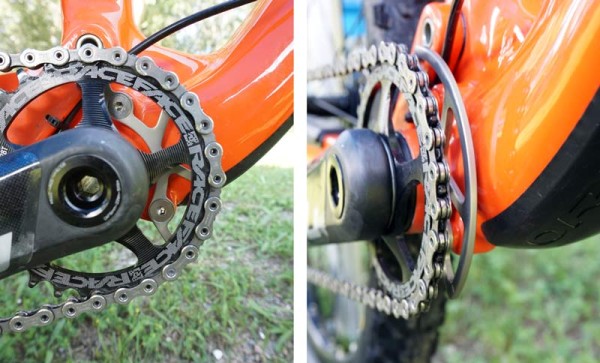
Speaking of double chainrings, any new mountain bikes from Orbea that ship with 11 speeds in the rear come with a 30mm spindle Race Face double crankset. Even better, they’ll also include a 28, 30 or 32 tooth direct mount chainring in case you want to switch from 2x to 1x. If you order it with the 1x setup, they’ll put the 2x parts in the box for you. It also ships with the chain guard shown above for 2x setups to prevent the chain from dropping off the small ring grinding into a massive chain suck. The front derailleur direct mounts are minimal, making them almost invisible when you remove it. You can also order an MRP chain guide to bolt onto the partial ISCG05 mounts as an upgrade option. Only the top and front bolt holes are present on the frame, so bash guards are not recommended.
That crankset is held inside a PF92 bottom bracket, which takes full advantage of the Boost width to make for a massively stiff structure on which to hammer. Most models will fit a Race Face crank in there, but some mid-range options will get Shimano 2×10 drivetrains. The rest of the drivetrain and brakes are all Shimano, with the 11-speed builds getting the larger 11-42 XT cassette even if the rest of the build is XTR level.
Internal cable routing abounds, running everything through the downtube before spitting it out on either side. Note the additional port on the seat tube. The rubber grommet can flip flop, letting you run an externally controlled dropper post through the frame up to that point and pointing the remote cable upward to the post, or you can run a stealth post’s cable outside the downtube and then into the seat tube.
“But how can I run the dropper cable outside the downtube?” you ask? Because they put bolt holes on the downtube and include removable cable guides. They’re actually designed to let you quickly add a new rear brake without having to run the hose internally, but will work just fine for dropper posts, too.
Shift cables come exit the downtube and run over bottom bracket, then wrap under the chainstay. That keeps it clean and means there’s not a cluster of hoses and housings protruding from the underside of the bike.
The bike will come with several additional cable ports for use with Di2 wires or single, double or triple cable housing sized holes. That lets you set up the bike with whatever accessories you want and still keep it internal or change up the drivetrain in the future without having to order additional small parts.
Another big improvement on the Occam is Orbea’s increased use of color matched components, decals and overall styling. Extensive use of Race Face parts is another bonus, and the sum total is a more cohesive, upscale appearance for the brand.
It’s taken to extremes on the top of the line Occam AM, which gets custom orange DT Swiss decals on their XMC 1200 carbon wheels:
Despite the two bikes having different travel and slightly different intended users, the wheel sizes follow the program set forth by the Oiz. Small, medium and large frames are available on the Occam AM 27.5” bike, and the Occam TR 29er gets a medium, large and XL size run. They did this because for a similar bike, their sales data suggested most taller riders are going to opt for the 29er bike, and the shortest riders will choose the 27.5, so they didn’t want to sit on inventory and make something that very few people would actually buy.
Now for more good news: They’re really light. If you recall, Orbea team racer Catharine Pendrel’s World Cup race-ready Oiz XC full suspension bike came in at 10.79kg with pedals. The Occam AM in the highest spec comes in at just 10.97kg (without pedals, size medium, set up tubeless – it’s the orange one shown above). So, that’s just a couple hundred grams heavier for 45mm more travel, a burlier fork and tires, and a dropper post. Not bad.
The alloy frames come in at 2,700g and look every bit as sexy as the carbon bikes. It’s a butted, hydroformed frameset that does get a rear axle pivot, which explains some of the weight gain but is still 100g lighter than the prior version. The pivot is concentric with the rear axle, which helps maintain similar stiffness as the carbon. (In case you’re curious, they say the Split Pivot and Trek designs are patented as complete systems that specify other pivot positions and specific suspension benefits. But a simple concentric axle/pivot was patented way back in the 1800’s and Orbea’s design doesn’t claim any specific suspension benefit, it’s more about frame stiffness and simplicity.)
One nice feature that the carbon bike doesn’t get is the breakaway direct mount rear derailleur hanger. It’s attached with a breakaway screw so it’ll snap off under any impact that would normally be enough to damage your rear mech. Even better, the hanger houses an extra screw so you can bolt it back on and get right back to riding. It’s almost as if they’ve thought of everything you’d need to set it up to your liking and keep it running should the eventual, inevitable accident happen.
The alloy frames lack the fancy cable ports but still have all the necessary holes to run things internally and/or handle dropper posts.
Available in August or September in standard models and through their MyO customization program that lets you choose component spec, suspension and frame color. Prices range from $2,199 to $7,999. Higher end models come with the Reverb Stealth dropper post, and mid-range bikes get their clever Digit manual dropper post. Full specs and pricing options will be added soon along with a complete post on the Digit, which is amazing. First ride impressions will also be posted separately from the Zona Zero trails near Ainsa, Spain!
